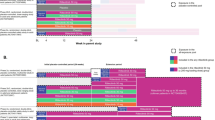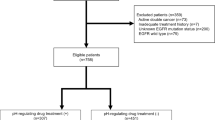Abstract
Purpose
To evaluate safety and tolerability of cediranib, a highly potent and selective vascular endothelial growth factor signaling inhibitor, in Japanese patients with advanced solid tumors refractory to standard therapies.
Methods
In part A (n = 16), patients received once-daily oral cediranib (10–45 mg) to identify the maximum tolerated dose (MTD). In part B (n = 24), patients with non-small-cell lung cancer or colorectal cancer received multiple daily doses at the MTD.
Results
Cediranib 30 mg/day was considered the MTD since 50% of evaluable patients receiving 45 mg/day experienced dose-limiting toxicities in part A (proteinuria and diarrhea n = 1, proteinuria n = 1, thrombocytopenia n = 1). The most common adverse events were diarrhea (n = 34) and hypertension (n = 32). Pharmacokinetic analysis confirmed cediranib as suitable for once-daily oral dosing. Of 32 evaluable patients, two had partial RECIST responses and 24 had stable disease ≥8 weeks.
Conclusions
Cediranib was generally well tolerated at ≤30 mg/day in these Japanese patients and showed encouraging antitumor activity.



Similar content being viewed by others
References
Carmeliet P, Jain RK (2000) Angiogenesis in cancer and other diseases. Nature 407:249–257
Ferrara N, Davis-Smyth T (1997) The biology of vascular endothelial growth factor. Endocr Rev 18:4–25
Veeravagu A, Hsu AR, Cai W et al (2007) Vascular endothelial growth factor and vascular endothelial growth factor receptor inhibitors as anti-angiogenic agents in cancer therapy. Recent Patents Anticancer Drug Discov 2:59–71
Nilsson M, Heymach JV (2006) Vascular endothelial growth factor (VEGF) pathway. J Thorac Oncol 1:768–770
Hicklin DJ, Ellis LM (2005) Role of the vascular endothelial growth factor pathway in tumor growth and angiogenesis. J Clin Oncol 23:1011–1027
Ferrara N, Gerber HP, LeCouter J (2003) The biology of VEGF and its receptors. Nat Med 9:669–676
McMahon G (2000) VEGF receptor signaling in tumor angiogenesis. Oncologist 5(Suppl 1):3–10
Wedge SR, Kendrew J, Hennequin LF et al (2005) AZD2171: a highly potent, orally bioavailable, vascular endothelial growth factor receptor-2 tyrosine kinase inhibitor for the treatment of cancer. Cancer Res 65:4389–4400
Maris JM, Courtright J, Houghton PJ et al (2008) Initial testing of the VEGFR inhibitor AZD2171 by the pediatric preclinical testing program. Pediatr Blood Cancer 50:581–587
Smith NR, James NH, Oakley I et al (2007) Acute pharmacodynamic and antivascular effects of the vascular endothelial growth factor signaling inhibitor AZD2171 in Calu-6 human lung tumor xenografts. Mol Cancer Ther 6:2198–2208
Drevs J, Siegert P, Medinger M et al (2007) Phase I clinical study of AZD2171, an oral vascular endothelial growth factor signaling inhibitor, in patients with advanced solid tumors. J Clin Oncol 25:3045–3054
Khosravi SP, Fernandez PI (2008) Tumoral angiogenesis: review of the literature. Cancer Invest 26:104–108
Hurwitz H, Fehrenbacher L, Novotny W et al (2004) Bevacizumab plus irinotecan, fluorouracil, and leucovorin for metastatic colorectal cancer. N Engl J Med 350:2335–2342
Sandler A, Gray R, Perry MC et al (2006) Paclitaxel-carboplatin alone or with bevacizumab for non-small-cell lung cancer. N Engl J Med 355:2542–2550
Johnson DH, Fehrenbacher L, Novotny WF et al (2004) Randomized phase II trial comparing bevacizumab plus carboplatin and paclitaxel with carboplatin and paclitaxel alone in previously untreated locally advanced or metastatic non-small-cell lung cancer. J Clin Oncol 22:2184–2191
Escudier B, Eisen T, Stadler WM et al (2007) Sorafenib in advanced clear-cell renal-cell carcinoma. N Engl J Med 356:125–134
Motzer RJ, Michaelson MD, Redman BG et al (2006) Activity of SU11248, a multitargeted inhibitor of vascular endothelial growth factor receptor and platelet-derived growth factor receptor, in patients with metastatic renal cell carcinoma. J Clin Oncol 24:16–24
Therasse P, Arbuck SG, Eisenhauer EA et al (2000) New guidelines to evaluate the response to treatment in solid tumors. European Organization for Research and Treatment of Cancer, National Cancer Institute of the United States, National Cancer Institute of Canada. J Natl Cancer Inst 92:205–216
Langenberg M, van Herpen CM, de Bono JS et al (2008) Optimal management of emergent hypertension during treatment with a VEGF signaling inhibitor: a randomized phase II study of cediranib. J Clin Oncol 26(15S):abst 3555
Curwen JO, Musgrove HL, Kendrew J et al (2008) Inhibition of vascular endothelial growth factor-A signaling induces hypertension: examining the effect of cediranib (Recentin; AZD2171) treatment on blood pressure in rat and the use of concomitant antihypertensive therapy. Clin Cancer Res 14:3124–3131
Li B, Ogasawara AK, Yang R et al (2002) KDR (VEGF receptor 2) is the major mediator for the hypotensive effect of VEGF. Hypertension 39:1095–1100
Raymond E, Faivre S, Vera K et al (2003) Final results of a phase I and pharmacokinetic study of SU11248, a novel multi-target tyrosine kinase inhibitor, in patients with advanced cancers. Proc Am Soc Clin Oncol 22:abst 769
Veronese ML, Flaherty KT, Townsend R et al (2004) Pharmacodynamic study of the raf kinase inhibitor BAY 43-9006: mechanisms of hypertension. J Clin Oncol 22(suppl):abst 2035
Hiles JJ, Kolesar JM (2008) Role of sunitinib and sorafenib in the treatment of metastatic renal cell carcinoma. Am J Health Syst Pharm 65:123–131
Motzer RJ, Hutson TE, Tomczak P et al (2007) Sunitinib versus interferon alfa in metastatic renal-cell carcinoma. N Engl J Med 356:115–124
Ramalingam SS, Mack PC, Vokes EE et al (2008) Cediranib (AZD2171) for the treatment of recurrent small cell lung cancer (SCLC): a California Consortium phase II study (NCI # 7097). J Clin Oncol 26(15S):abst 8078
Hirte HW, Vidal L, Fleming GF et al (2008) A phase II study of cediranib (AZD2171) in recurrent or persistent ovarian, peritoneal or fallopian tube cancer: final results of a PMH, Chicago and California consortia trial. J Clin Oncol 26(15S):abst 5521
Acknowledgments
This study, including medical writing support provided by Rebecca Helson of Mudskipper Bioscience, was supported financially by AstraZeneca. RECENTIN™ is a trade mark of the AstraZeneca group of companies. Noboru Yamamoto and Tomohide Tamura have received remuneration from AstraZeneca KK and Eisei Shin has stock ownership.
Author information
Authors and Affiliations
Corresponding author
Rights and permissions
About this article
Cite this article
Yamamoto, N., Tamura, T., Yamamoto, N. et al. Phase I, dose escalation and pharmacokinetic study of cediranib (RECENTIN™), a highly potent and selective VEGFR signaling inhibitor, in Japanese patients with advanced solid tumors. Cancer Chemother Pharmacol 64, 1165–1172 (2009). https://doi.org/10.1007/s00280-009-0979-8
Received:
Accepted:
Published:
Issue Date:
DOI: https://doi.org/10.1007/s00280-009-0979-8




